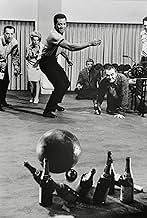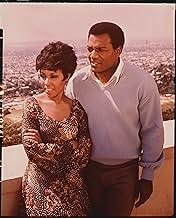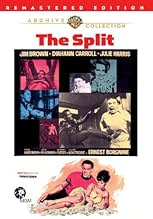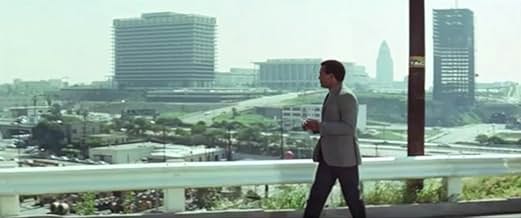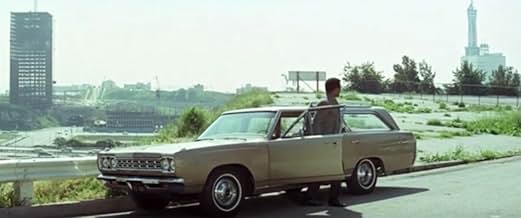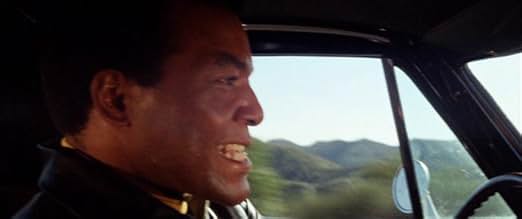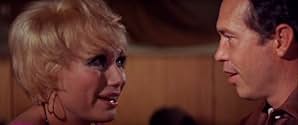AVALIAÇÃO DA IMDb
6,0/10
1,6 mil
SUA AVALIAÇÃO
Ladrões caem quando mais de meio milhão de dólares desaparecem após o ousado e cuidadosamente planeado roubo do Coliseu de Los Angeles durante um jogo de futebol, cada um acusando o outro de... Ler tudoLadrões caem quando mais de meio milhão de dólares desaparecem após o ousado e cuidadosamente planeado roubo do Coliseu de Los Angeles durante um jogo de futebol, cada um acusando o outro de ter o dinheiro.Ladrões caem quando mais de meio milhão de dólares desaparecem após o ousado e cuidadosamente planeado roubo do Coliseu de Los Angeles durante um jogo de futebol, cada um acusando o outro de ter o dinheiro.
- Direção
- Roteiristas
- Artistas
Priscilla Ann
- Daughter
- (não creditado)
Thordis Brandt
- Police Clerk
- (não creditado)
Calvin Brown
- Guard Charlie
- (não creditado)
Antony Carbone
- Man
- (não creditado)
Dee Carroll
- Payroll Clerk
- (não creditado)
- Direção
- Roteiristas
- Elenco e equipe completos
- Produção, bilheteria e muito mais no IMDbPro
Avaliações em destaque
7tavm
After football great Jim Brown died recently, I decided to watch two of his films he made after retiring from the sport that made him famous. I've long been interested in watching this one because I found out it was the first one to be rated R after the Motion PIcture Association of America (now simply reduced to Motion Picture Association) started doing the letter ratings system. R at the time meant that "no one under 16 admitted without parent or adult guardian" only raising the age limit to 17 two years later. Anyway, Brown ends up planning a heist of the box office earnings from a football game with Donald Sutherland, Ernest Borgnine (two of Brown's previous co-stars from The Dirty Dozen), Warren Oates, Jack Klugman, and Julie Harris in on the action. Diahann Carroll is his leading lady and Gene Hackman is a police detective on the trail. I liked most of the goings-on most of the time though I admit some scenes confused me. But The Split was really intriguing to me especially when Quincy Jones' score was used. So I recommend The Split for anyone looking for one of Jim Brown's early films. Next, I'll review him in El Condor.
The cast list of this film reads like a who's who of 60's and 70's Hollywood character actors. While they don't all get a chance to really shine here, their familiar faces and inherent skills help move this heist flick along nicely. Brown is a ne'er do well thief who returns to Los Angeles just in time to help Harris mastermind the robbery of the L.A. Coliseum during a Rams play-off game. He enlists the aid of four disparate men (Borgnine, Klugman, Oates and Sutherland) who form a tenuous alliance, working as a unit just long enough to get the job done and split the $500,000 take. The heist itself is suspensefully handled and skillfully done, but the primary thrust of the story kicks in when it's time to divvy out the loot, hence the title of the film (brought home even more in the title of the source novel.) Brown, though stiff at times, is such a physical presence (and an amiable one) that he anchors the story well, faltering only when it's called upon him to enact scenes of grief. Harris is tough-as-nails as a hard, (big!) red-haired schemer. All of the men in the gang give their customary polished and distinct performances. Borgnine is, of course, the most blustery. Klugman (who would return to this venue in "Two Minute Warning") plays the nervous one. Oates gives the most texture to his role as a wary safe-cracker. Sutherland is a class-act hit man with the necessary cool and effortlessness. Carroll is very attractive in a thankless role of decoration/plot device. Hackman turns up late as the police detective assigned to a murder related to the heist and gives a decent performance. Trivia buffs will note that one of the clerks (Joseph) provided the voice of Melody in the 70's cartoon series "Josie and the Pussycats". Nearly all of the roles in the film are filled with people who worked extensively as guest stars in major television series. The film is creatively directed, contains bouncy Quincy Jones music and clips along at a very tight pace except for a mouthwash commercial-esque romantic montage between Brown and Carroll. Some of the plot elements are pretty preposterous (such as Brown's initial sequences of "auditioning" the heist participants), but it makes for interesting viewing. The movie serves as a fun time capsule of the era's fashions and procedures (check out the hair on Borgnine's secretary!) The story is never completely predictable and is at home with other similar (if more polished and better known) films from that time such as "Bullit" and "The Thomas Crown Affair".
Near the beginning of this film, there is a fistfight, but it's not exciting because we don't know why the two men are fighting. A little later, there is a car chase, but it's not exciting either, because we don't know who's chasing whom or why. Later still, we find out the answers to those questions, but two potentially good action scenes have been wasted. And then the movie turns into a standard heist flick....thankfully only for a while. The focus here is not on the actual heist, but more on the aftermath. And it's there that the movie finally goes in unexpected directions.
There is, for example, the bizarre scene in which a man gets off on shooting someone with a machine-gun. There is the memorable image of a white sheet that gradually "absorbs" the blood of the body that's underneath it, and red spots start appearing on it. And there some neat plot twists along the way, mostly involving a character (I won't say which) that enters the picture when you least expect him to.
If the whole movie was as good as its final 30 minutes, I'd give it one more star, but for now this gets a ** rating.
There is, for example, the bizarre scene in which a man gets off on shooting someone with a machine-gun. There is the memorable image of a white sheet that gradually "absorbs" the blood of the body that's underneath it, and red spots start appearing on it. And there some neat plot twists along the way, mostly involving a character (I won't say which) that enters the picture when you least expect him to.
If the whole movie was as good as its final 30 minutes, I'd give it one more star, but for now this gets a ** rating.
The books of crime novelist Donald Westlake (usually writing as "Richard Stark") have made for some fairly interesting movies for almost half a century now. The first real one was in 1967, when his novel "The Hunter" was the basis for the John Boorman-directed cult classic POINT BLANK (with Lee Marvin); and there have been others: THE HOT ROCK (with George Segal and Robert Redford, from 1972); THE OUTFIT (with Robert Duvall and Robert Ryan, released in 1974); and BANK SHOT (with George C. Scott, also released in 1974).
And then there's 1968's THE SPLIT.
Based on Westlake's book "The Seventh", the film is a classically themed Hollywood heist film, involving a group of thieves robbing the cash office at the Los Angeles Memorial Coliseum during a playoff game between the Los Angeles Rams and the Atlanta Falcons. Former NFL legend Jim Brown, who turned to acting after retiring from the Cleveland Browns in 1965 and became a star in Robert Aldrich's 1967 classic THE DIRTY DOZEN, is the leader of this group that includes his fellow DIRTY DOZEN cast members Donald Sutherland and Ernest Borgnine; Jack Klugman (one of the jurors in the 1957 classic TWELVE ANGRY MEN); and veteran character actor Warren Oates. The heist goes off with almost laser-like perfection, but it's what happens thereafter--the complications; the screw-ups; and the betrayals--that are the real payoff. Gene Hackman, who had at the time recently leaped to acting prominence as a result of his role in BONNIE AND CLYDE, portrays a seedy Los Angeles cop (perhaps presaging his Oscar-winning turn in THE FRENCH CONNECTION); and Diahann Carroll and Julie Harris are the women involved. James Whitmore plays a superbly seedy landlord at Carroll's apartment.
By 21st century standards, this must seem terribly old-fashioned: there are no hyper-violent, over-the-top stunts, no CGI bloodshed, or any of that extraneous junk. And this is clearly a film of the late 1960s, in terms of costumes, hairstyles, and all of that—this and, of course, the fact that the Rams were L.A.'s pro-football team too. And yet, even though it doesn't necessarily stand out among the many great crime heist films, from Stanley Kubrick's THE KILLING to Sam Peckinpah's THE GETAWAY, or even the 1988 blockbuster DIE HARD, there's still something hugely fascinating about THE SPLIT, in terms of the way suspense is built up. Perhaps part of the reason it isn't as well-known as it should be is that the director, British-born Gordon Flemyng, was not a known entity, save for a couple of episodes of the TV series "The Avengers", and the 1965's DR. WHO AND THE DALEKS. All the same, though, the cast still does well under Flemyng's direction, with very good cinematography by Burnett Guffey (who won an Oscar for BONNIE AND CLYDE), and a taut, early action film music score by Quincy Jones, who had done major work on THE PAWNBROKER, IN THE HEAT OF THE NIGHT, and IN COLD BLOOD. This was also the first film to be released following the establishment of the movie ratings system by the MPAA where the for-adults 'R' rating was placed, even though it is closer to a 'PG-13' rating by today's ultra-violent standards.
Imperfect and dated as it is at times, I'd still give THE SPLIT a '7' rating, simply because of the surface pleasures of the piece.
And then there's 1968's THE SPLIT.
Based on Westlake's book "The Seventh", the film is a classically themed Hollywood heist film, involving a group of thieves robbing the cash office at the Los Angeles Memorial Coliseum during a playoff game between the Los Angeles Rams and the Atlanta Falcons. Former NFL legend Jim Brown, who turned to acting after retiring from the Cleveland Browns in 1965 and became a star in Robert Aldrich's 1967 classic THE DIRTY DOZEN, is the leader of this group that includes his fellow DIRTY DOZEN cast members Donald Sutherland and Ernest Borgnine; Jack Klugman (one of the jurors in the 1957 classic TWELVE ANGRY MEN); and veteran character actor Warren Oates. The heist goes off with almost laser-like perfection, but it's what happens thereafter--the complications; the screw-ups; and the betrayals--that are the real payoff. Gene Hackman, who had at the time recently leaped to acting prominence as a result of his role in BONNIE AND CLYDE, portrays a seedy Los Angeles cop (perhaps presaging his Oscar-winning turn in THE FRENCH CONNECTION); and Diahann Carroll and Julie Harris are the women involved. James Whitmore plays a superbly seedy landlord at Carroll's apartment.
By 21st century standards, this must seem terribly old-fashioned: there are no hyper-violent, over-the-top stunts, no CGI bloodshed, or any of that extraneous junk. And this is clearly a film of the late 1960s, in terms of costumes, hairstyles, and all of that—this and, of course, the fact that the Rams were L.A.'s pro-football team too. And yet, even though it doesn't necessarily stand out among the many great crime heist films, from Stanley Kubrick's THE KILLING to Sam Peckinpah's THE GETAWAY, or even the 1988 blockbuster DIE HARD, there's still something hugely fascinating about THE SPLIT, in terms of the way suspense is built up. Perhaps part of the reason it isn't as well-known as it should be is that the director, British-born Gordon Flemyng, was not a known entity, save for a couple of episodes of the TV series "The Avengers", and the 1965's DR. WHO AND THE DALEKS. All the same, though, the cast still does well under Flemyng's direction, with very good cinematography by Burnett Guffey (who won an Oscar for BONNIE AND CLYDE), and a taut, early action film music score by Quincy Jones, who had done major work on THE PAWNBROKER, IN THE HEAT OF THE NIGHT, and IN COLD BLOOD. This was also the first film to be released following the establishment of the movie ratings system by the MPAA where the for-adults 'R' rating was placed, even though it is closer to a 'PG-13' rating by today's ultra-violent standards.
Imperfect and dated as it is at times, I'd still give THE SPLIT a '7' rating, simply because of the surface pleasures of the piece.
Though I think Leonard was a little harsh, "The Split" still isn't a very good movie. The characters are paper-thin, scenes seem to be missing, and the movie is generally predictable. And there are some unbelievable scenes, like when Jim Brown's character "tests" the potential recruits. The lame climax you've seen in countless other movies.
On the positive side, there is quite a bit of A-T-T-I-T-U-D-E here, which only something from this time period could pull off. There's a great scene when Borgnine and Brown slug it out. And the Quincy Jones soundtrack is great. I suspect the music is behind the reason why this has never been released on video.
On the positive side, there is quite a bit of A-T-T-I-T-U-D-E here, which only something from this time period could pull off. There's a great scene when Borgnine and Brown slug it out. And the Quincy Jones soundtrack is great. I suspect the music is behind the reason why this has never been released on video.
Você sabia?
- CuriosidadesWhile promoting this film, Jim Brown told critic Roger Ebert "What I want to do is play roles as a black man, instead of playing black man's roles. You know? The guy in 'The Split,' for example, could be any color. And I don't make a big thing out of my race. If you try to preach, people give you a little sympathy and then they want to get out of the way. So you don't preach, you tell the story. I have a theory, an audience doesn't need to get wrapped up in blackness every time they see a Negro actor. And a movie doesn't have to be about race just because there's a Negro in it. If there's a bigot in the audience, he has to keep reminding himself, that's a black man, that's a Negro, because the story line has left him 'way behind, man. Away behind. Just tell the story, and before you know it, that cat will be identifying with you, and he won't even know how it happened."
- Erros de gravaçãoDuring the car chase scenes between McClain and Kifka, they are mainly on dirt roads, but tires are heard squealing - which does not happen on unpaved roads.
- Citações
Dave Negli: Listen, Marty, the last man I killed I did it for $5000. For $85,000 I'd kill you 17 times.
- ConexõesFeatured in Jim Brown: All American (2002)
Principais escolhas
Faça login para avaliar e ver a lista de recomendações personalizadas
- How long is The Split?Fornecido pela Alexa
Detalhes
- Data de lançamento
- País de origem
- Idioma
- Também conhecido como
- El atraco al estadio
- Locações de filme
- Los Angeles Memorial Coliseum - 3911 S. Figueroa Street, Exposition Park, Los Angeles, Califórnia, EUA(Stadium and football game footage)
- Empresas de produção
- Consulte mais créditos da empresa na IMDbPro
- Tempo de duração1 hora 30 minutos
- Mixagem de som
- Proporção
- 2.39 : 1
Contribua para esta página
Sugerir uma alteração ou adicionar conteúdo ausente


